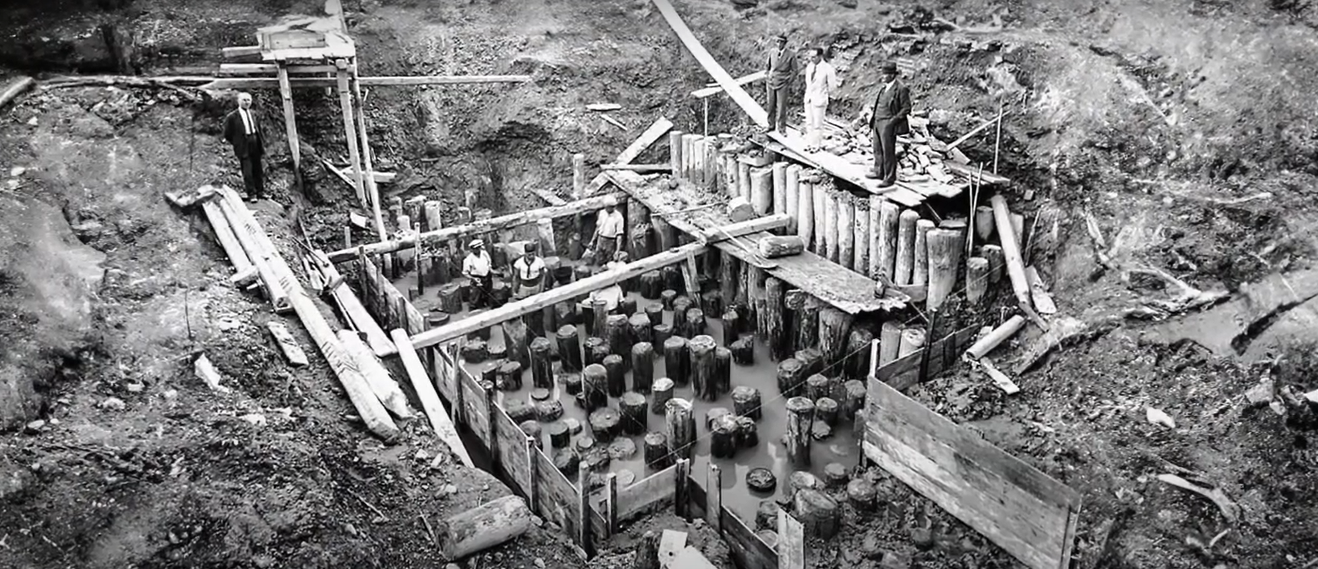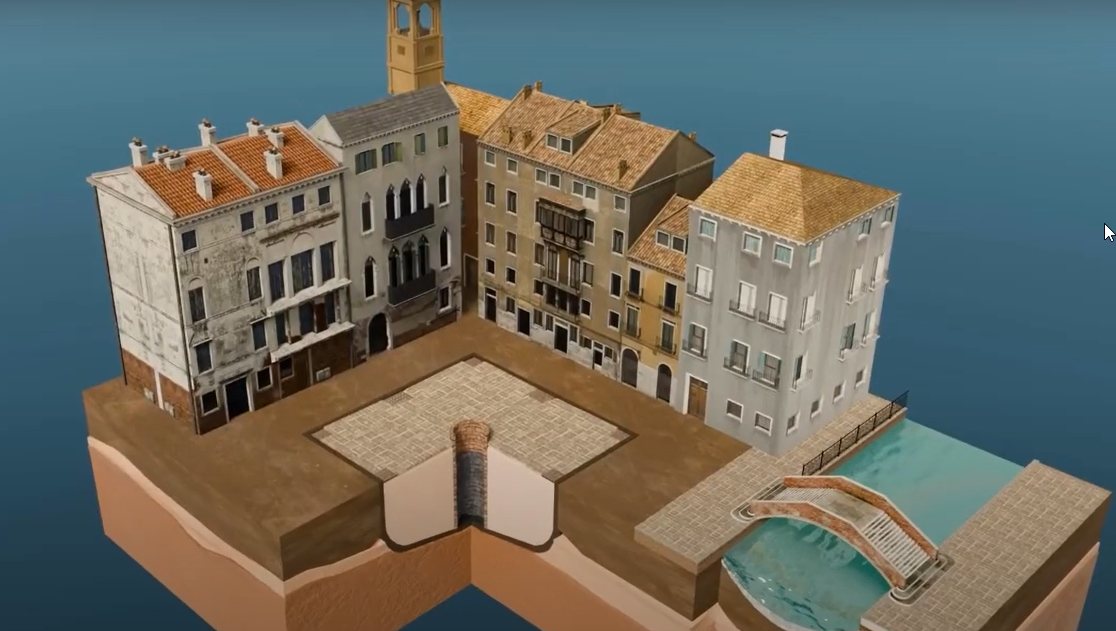Foundations of Venice – Engineering a City on Water
Despite having no roads, no land and no fresh water, the Venetians managed to turn a muddy swamp into the most powerful and wealthiest city of its time. This unique layout of canals and bridges woven through hundreds of islands made Venice incredibly accessible, and it became the epicenter of all business. We modeled the entire thing to show you what's going on beneath the surface and how its clever design and medieval engineering allowed it to take over the world.
When the first refugees arrived to start their new lives on the islands, they had the worst possible surface to build on; the small, marshy islands were made of an incredibly soft clay, which would barely hold the weight of a human, let alone an entire city. To create stable foundations for buildings, the Venetians collected large timber piles from the forests of Croatia and started hammering them into the ground. They drove them about 5 meters deep until they reached a much harder layer of clay. Not only did this stabilize the piles, but by packing them really close together, it compressed the surrounding clay, pushing out the water and making it much stronger. Once the piles were firmly in the ground, the tops were cut off and wooden planks delayed on top to spread the load. Special blocks of Istrian stone were then placed to raise the foundations above the water. This design was a stroke of genius as the wooden piles were sealed away from the air, making it impossible for them to rot. To this day, almost all of the original piles are in great condition and are still holding up the city.

Expansion and Trade – The Rise of a Maritime Power
Once the foundation had been properly laid down, the buildings themselves were built. Venetians started off using wood for their houses, but after numerous fires, they switched to brick to keep the buildings as lightweight as possible, they had to be no more than three stories high. Lime mortar had to be used instead of cement because it was flexible and would allow the entire building to flex as the ground beneath slowly moved, the inner walls were built in a crisscross pattern that would also flex like a trellis. The facade walls, which had large windows and elegant stone designs, made them much heavier and so in order to stop them from falling over, they were pinned into the floor using iron rods, keeping the entire building together. This method of building worked well for the Venetians, and soon several islands around the lagoon were established in this way.
Instead of expanding outwards like most cities, these islands expanded into each other. At first, boats were the only way to cross between the islands, but eventually the islands grew closer together and many could be crossed by simply wading through the shallow water on a horse. The next step in Venus's evolution would, of course, be connecting the islands. Surprisingly, there were no bridges for the first 500 years of Venice's existence, but as the population increased and business started to ramp up, there needed to be an easier way to reach Rialto, the financial center of Venice. And so, the Doge of Venice set up a prize for the engineer that could design the best bridge.
In order to turn Venice from a collection of islands into a bustling city, bridges had to be built. The first attempt was a simple pontoon bridge that joined the two largest sections of Venice together and crucially, provided quick access to the Rialto area. The bridge was later upgraded to a wooden bridge, which eventually burned down and collapsed before it was finally replaced by a much stronger - stone bridge. To build it over 12,000 timber piles were driven into the banks of the canal and 10,000 tons of stone were built on top to form the bridge. To this day, the bridge still stands and it serves as the main artery in the center of Venice.
After this stone bridges started to pop up everywhere, turning Venice into a compact city made-up entirely of canals instead of roads, this gave Venice a unique advantage. Since the canals allowed goods and traffic to flow quickly through every part of the city, the messy overlap of pedestrians and horse drawn traffic didn't exist in Venice. Since the walkways and canals were completely separated, yet people could transition between the two effortlessly without slowing down. By now, the city had become the most powerful and richest city in Europe. Everything was bought and sold went through Venice and the Venetians were making enormous amounts of money.
Water, Waste, and Sustainability – Venice’s Ingenious Solutions
But as business increased, so did the population and the demand for fresh water was out of control. Despite being surrounded by water, Venice couldn't use any of it since it was extremely salty and undrinkable. Without natural springs or rivers to collect fresh water, Venice relied upon boats to deliver water from the mainland. But with 170,000 people, the demand became too much, and the Venetian engineers had to get creative.
From the beginning, Venetian Islands were built around squares, which were initially just empty fields for animals to graze upon. The idea was to use these squares to collect rainwater. They started by digging out large areas under the entire square and lining the walls with a thick layer of clay to make it waterproof. The space was then filled in with sand and stones, and the surface was redone with tiles that would lead the water towards each corner of the square. From here, rainwater would flow into the basin and gradually filter through the sand and stones until it reached the main well at the center of the squares.

To maximize the surface area for water collection, the roofs of the nearby buildings were fitted with gutters that would direct the water onto the square and into the drains. Venice then became an enormous funnel, which filled more than 600 wells around the city. The Venetians had once again engineered a masterpiece to save its city.
But there was still one huge problem - waste. Until this point, people threw all of their waste out of the window, some of it landing in the canal. But for those who didn't live within throwing distance of a canal, urine, feces, and rotten food all ended up in the streets. And so, in the 16th century, the Venetians started building a network of underground tunnels. That would collect the waste from every building and flush it into the canals; when the tide of the lagoon was down, solid waste would collect at the bottom and the liquids would naturally flow into the canals. Then, when the tide rose, it would flood the tunnels. And pull the solid waste into the canal. The motion of the tide coming in and out twice a day would exchange the dirty water for fresh water from the sea, flushing Venice from all of its waste. The extremely salty water worked as a strong disinfectant and thanks to this system, the streets became clean.

Amazingly, almost all of the incredible engineering that made Venice is still around today. The bridges, the canals, the buildings are ancient relics sitting on a forest that has held up the entire city for over 1000 years.
Source: Primal Space. (2024, July 30). The Crazy Engineering of Venice [Video]. YouTube. https://www.youtube.com/watch?v=77omYd0JOeA